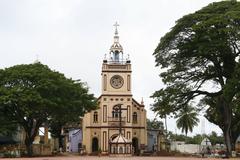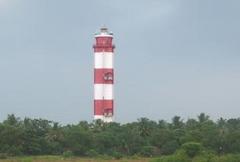
Comprehensive Guide to Visiting Ernakulam, Kochi, India
Date: 14/08/2024
Captivating Introduction
Imagine a city where the past and present dance in perfect harmony, where every street corner whispers tales of ancient traders, colonial conquests, and cultural fusions. Welcome to Ernakulam, the beating heart of Kochi, India. This vibrant city isn’t just a destination; it’s an experience. From the aroma of spices in the bustling markets to the serene sunsets over the backwaters, Ernakulam promises an adventure for every sense.
Picture this: It’s the 14th century, and a cataclysmic flood has just transformed a sleepy village into a bustling port city. This is the beginning of Ernakulam’s enchanting journey, a journey that has seen merchants from Persia, Rome, Arabia, and China flock to its shores (Travel4History). Fast forward to the 16th century, and Portuguese explorers like Vasco da Gama are leaving their mark, followed by Dutch and British influences that have shaped the city’s unique architectural landscape (Wikivoyage).
But Ernakulam isn’t just about its rich history. It’s a city that celebrates diversity in every form. From the Jewish Quarter with its ancient Paradesi Synagogue dating back to 1568 (Travel4History) to the vibrant cultural scene that includes everything from Kathakali performances to contemporary art at the Kashi Art Café, Ernakulam is a melting pot of experiences waiting to be discovered.
Whether you’re strolling down Marine Drive with the cool sea breeze ruffling your hair, exploring hidden temples that seem to hold the secrets of centuries, or indulging in the local cuisine that promises a burst of flavors in every bite, Ernakulam is a city that captivates, charms, and enchants. So pack your bags, put on your explorer’s hat, and get ready to dive into the rich tapestry of Ernakulam, Kochi, India.
Table of Contents
- Historical Significance of Ernakulam, Kochi, India
- Key Attractions
Historical Significance of Ernakulam, Kochi, India
A Glimpse into Ernakulam’s Enchanting Past
Welcome to Ernakulam, the heart of Kochi and a treasure trove of history and culture! Did you know that this vibrant city’s journey began with a cataclysmic flood in 1341? Yes, the Great Floods of the Periyar River turned this sleepy locale into a bustling port city, setting the stage for centuries of trade and cultural exchange. Intrigued? Let’s dive deeper!
Formation and Early History
Ernakulam, nestled in the larger Kochi metropolitan area, boasts a history as rich as a perfectly spiced Kerala curry. The Great Floods of 1341 weren’t just a natural disaster; they were nature’s way of crafting a vital trading hub. Merchants from Persia, Rome, Arabia, and China flocked to this new port, each leaving their mark on the city (Travel4History).
Colonial Era
Portuguese Influence
Picture this: It’s the early 16th century, and Portuguese ships are sailing into Kochi’s harbor. The famous explorer Vasco da Gama even made his final voyage here, leaving an indelible mark on the city’s history. The Portuguese built Fort Emmanuel to protect their trading interests, remnants of which still whisper stories of old (Travel4History).
Dutch Conquest
Fast forward to 1663, and the Dutch East India Company takes the reins. Their influence is etched in the city’s architecture—just visit the Dutch Cemetery from 1664 or stroll past houses built in the Amsterdam style. It’s like taking a European detour without leaving India (Travel4History).
British Rule
By 1814, the British were calling the shots, thanks to the Anglo-Dutch Treaty. They left their footprint in Fort Kochi and British Ernakulam, establishing administrative and commercial centers. Fancy a walk through British history? These areas are your go-to (Wikivoyage).
Jewish Influence
One of Kochi’s most unique aspects is its Jewish heritage. Jewish traders set up shop here in 1524, creating the Jewish Quarter and the Paradesi Synagogue—the oldest in India, dating back to 1568. It’s a must-visit for a peek into Kochi’s multicultural past (Travel4History).
Modern Era
Ernakulam has evolved into Kerala’s commercial powerhouse since the state’s formation in 1957. The city is a blend of modernity and tradition, with a booming economy focused on tourism, IT, and its ever-busy port (Wikivoyage).
Key Historical Sites
Fort Kochi
This is where it all comes together. Fort Kochi is a melting pot of Portuguese, Dutch, and British influences. The Mattancherry Palace, or Dutch Palace, wows with mural paintings from Hindu epics, while the Jewish Quarter and Paradesi Synagogue offer a unique cultural insight (Travel4History).
Mattancherry Palace
Built by the Portuguese and spruced up by the Dutch, Mattancherry Palace is a colonial architecture gem. From stunning mural paintings to royal artifacts, this palace is a living museum of Kochi’s past (Kerala Tourism).
Bolgatty Palace
Constructed by the Dutch in 1744, Bolgatty Palace has seen Dutch governors and British residents. Today, it’s a heritage hotel where you can experience colonial grandeur firsthand (Kerala Tourism).
Hill Palace Museum
For a deep dive into royal history, the Hill Palace Museum is your destination. It’s Kerala’s largest archaeological museum, showcasing artifacts from the regal lives of Kochi’s Maharajas (Special Places of India).
Cultural Significance
Kochi is the cultural cocktail you never knew you needed. With influences from Portuguese, Dutch, Arab, Chinese, and even Japanese cultures, it’s a cosmopolitan wonderland. Add in a significant Christian population and you’ve got a city that celebrates diversity like no other (Wikivoyage).
Hidden Gems and Local Secrets
Want to explore beyond the tourist traps? Check out the quaint Dhobi Khana where traditional laundrymen still ply their trade. Or visit the lesser-known Kashi Art Café for an artistic retreat and some of the best coffee in town. And don’t miss the secret spice markets of Mattancherry for a sensory overload!
Sensory Overload
Imagine the aroma of fresh spices wafting through the air, the vibrant colors of local markets, the rhythmic sounds of Kathakali performances, the taste of a perfectly cooked fish curry, and the feel of a fresh sea breeze. Ernakulam is a feast for the senses!
Interactive Adventures
Why not turn your visit into a quest? Try finding all the different architectural styles in Fort Kochi, or embark on a culinary tour to sample local delicacies. Can you try at least five different types of appam?
Cultural Etiquette and Local Lingo
When in Ernakulam, do as the locals do! Respect local customs like removing your shoes before entering homes and temples. And here’s a quick Malayalam lesson: “Namaskaram” means hello, and “Nanni” means thank you. Sprinkle these into your conversations and watch the locals beam!
Visitor Tips
- Best Time to Visit: October to March, when the weather is as pleasant as a stroll along Marine Drive.
- Local Transport: Hop on a bus, auto-rickshaw, ferry, or the convenient Kochi Metro. Getting around has never been easier!
- Accommodation: From luxury hotels to charming hostels, Ernakulam has it all. Fort Kochi is a favorite for its historical allure.
- Cuisine: Don’t miss out on local delights like appam and fish curry. Your taste buds will thank you!
- Shopping: The Jewish Quarter and MG Road are perfect for picking up spices, handicrafts, and more.
Key Attractions
Historical and Cultural Sites
Kochangadi Synagogue
Step back in time at the Kochangadi Synagogue, one of the oldest Jewish houses of worship in India. Established by the Malabari Jews, this ancient marvel dates back to the first century BCE. Imagine the stories these walls could tell—of traders braving the seas, of communities fleeing persecution and finding refuge here. For a dose of history, this is your spot (JTA).
Paradesi Synagogue
In the heart of Jew Town lies the Paradesi Synagogue, a 16th-century gem that still sparkles today. Built in 1568, it’s the oldest active synagogue in the Commonwealth of Nations. Walk in and be mesmerized by the Belgian glass chandeliers, the gold pulpit, and the hand-painted Chinese tiles. Each tile tells a story—can you decipher them all? (Travel4History)
St. George’s Church, Kadamattom
Blend mysticism with history at St. George’s Church in Kadamattom. Known for its unique mix of Kerala and Persian architecture, this church is tied to the legendary Kadamattathu Kathanar, a priest said to possess magical powers. The serene environment and the aura of mystery make it a must-visit (Holidify).
Thrikkakkara Vamana Moorthy Temple
Celebrate Kerala’s traditions at the Thrikkakkara Vamana Moorthy Temple, dedicated to Lord Vamana, an incarnation of Lord Vishnu. Especially significant during the Onam festival, this temple is a vibrant showcase of local culture and architecture. Walk through its halls and feel the pulse of Kerala’s rich religious traditions (Holidify).
Natural Attractions
Cherai Beach
Golden sands, calm waters, and the occasional dolphin sighting—Cherai Beach is pure bliss. Located about 25 kilometers from Ernakulam, it’s perfect for swimming, sunbathing, or simply relaxing. Look out for the iconic Chinese fishing nets that dot the landscape, adding a touch of local flavor (Holidify).
Ezhattumugham
Escape to nature at Ezhattumugham, a scenic village on the banks of the Chalakudy River. Known for its lush greenery and waterfalls, this eco-village promotes sustainable tourism. Pack a picnic, take a nature walk, or indulge in bird watching—this is nature at its finest (Holidify).
Paniyeli Poru
For the adventurous souls, Paniyeli Poru is a hidden gem waiting to be explored. Located about 20 kilometers from Ernakulam, its rocky terrain, rapids, and dense forests make it ideal for trekking, bird watching, and photography. Keep your eyes peeled for unique flora and fauna (Holidify).
Modern Attractions
Marine Drive
A bustling promenade with stunning views of the backwaters and Kochi Harbour, Marine Drive is the heartbeat of Ernakulam. Lined with shops, cafes, and restaurants, it’s a favorite spot for both locals and tourists. Don’t miss the iconic Rainbow Bridge and the Chinese Fishing Net Bridge. Evening boat cruises are a hit, offering a unique perspective of the city (Tripoto).
Lulu Mall
Shop till you drop at Lulu Mall, one of India’s largest shopping malls. Located in the heart of Ernakulam, it features a myriad of international and domestic brands, a multiplex, an ice skating rink, and a variety of dining options. It’s the ultimate destination for shopping, entertainment, and leisure (Tripoto).
Visitor Tips
Best Time to Visit
The best time to visit Ernakulam is from October to February, when the weather is pleasant and perfect for sightseeing. This period also coincides with several local festivals, offering a glimpse into the region’s vibrant culture (Holidify).
How to Reach
Ernakulam is well-connected by air, rail, and road. The Cochin International Airport is about 27 kilometers from the city center, offering flights to major domestic and international destinations. Ernakulam Junction and Ernakulam Town are the main railway stations, providing connectivity to various parts of India. The city is also accessible by road, with regular bus services from neighboring states (Holidify).
Local Transport
Getting around Ernakulam is a breeze with buses, auto-rickshaws, taxis, and ferries. The Kerala State Road Transport Corporation (KSRTC) operates an extensive network of buses within the city and to nearby destinations. Auto-rickshaws and taxis are readily available for short distances. Ferries offer a scenic and efficient way to navigate the backwaters (Holidify).
Nearby Attractions
Munnar
A picturesque hill station about 130 kilometers from Ernakulam, Munnar is known for its tea plantations, rolling hills, and cool climate. Key attractions include the Eravikulam National Park, Mattupetty Dam, and Anamudi Peak (Holidify).
Alleppey
Famous for its backwaters and houseboat cruises, Alleppey (Alappuzha) is located about 60 kilometers from Ernakulam. Experience the serenity of cruising through backwaters surrounded by lush greenery and traditional Kerala villages (Holidify).
Kumarakom
Another popular backwater destination, Kumarakom is about 50 kilometers from Ernakulam. Known for its bird sanctuary, houseboat cruises, and luxury resorts, the major attraction here is Vembanad Lake, the largest lake in Kerala (Holidify).
Ooty
A charming hill station about 270 kilometers from Ernakulam, Ooty (Udhagamandalam) is known for its tea gardens, botanical gardens, and the Nilgiri Mountain Railway. It offers a refreshing escape from Kerala’s tropical climate (Holidify).
Vagamon
A serene hill station about 100 kilometers from Ernakulam, Vagamon is known for its lush meadows, pine forests, and tea estates. It’s ideal for trekking, paragliding, and nature walks (Holidify).
Seasonal Highlights
Ernakulam transforms with the seasons, each bringing its own charm. From the vibrant festivals in the winter to the lush landscapes of the monsoon, there’s always something unique to experience. Plan your visit to coincide with local festivals like Onam or the Cochin Carnival for an unforgettable experience.
Local Lingo Lessons
Want to impress the locals? Here are some key Malayalam phrases to get you started:
- Namaskaram (Hello)
- Nanni (Thank you)
- Ente peru (My name is)
- Sukhamaano? (How are you?)
Fun Facts and Surprises
Did you know that Ernakulam is home to India’s first church, St. Thomas Church? Or that the city’s name is derived from the Tamil word ‘Erayanarkulam,’ meaning Lord Shiva’s abode? Ernakulam is full of surprises waiting to be discovered!
Call to Action
Ready to unlock the secrets of Ernakulam? Download the Audiala app and let it be your guide! Whether you’re a history buff, a foodie, or an adventure seeker, Audiala offers expert insights and hidden gems to make your trip unforgettable. Download now and start your Ernakulam adventure!
References
- Travel4History. (n.d.). Kochi Travel Guide. Travel4History
- Wikivoyage. (n.d.). Kochi. Wikivoyage
- JTA. (2024). Queenie Hallegua, Second-to-Last Jewish Resident of Historic Indian Jewish Community, Dies at 89. [JTA](https://www.jta.org/2024/08/12/obituaries/queenie-hallegua-second-to-last



